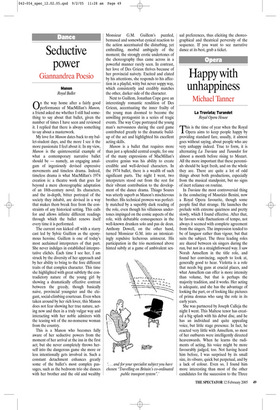Seductive power
Giannandrea Poesio
Manon Royal Ballet On the way home after a fairly good performance of MacMillan’s Manon, a friend asked me whether I still had something to say about that ballet, given the number of times I have seen and reviewed it. I replied that there is always something to say about a masterwork.
My love for Manon dates back to my ballet-student days, and the more I see it the more passionate I feel about it. In my view, Manon is the quintessential example of what a contemporary narrative ballet should be — namely, an engaging amalgam of ingeniously devised expressive movements and timeless drama. Indeed, timeless drama is what MacMillan’s 1974 creation is: a theatre work that goes far beyond a mere choreographic adaptation of an 18th-century novel. Its characters, and the in-depth, bitter portrayal of the society they inhabit, are devised in a way that makes them break free from the constraints of any historical setting. This calls for and allows infinite different readings through which the ballet renews itself every time it is performed.
The current run kicked off with a starry cast led by Sylvie Guillem as the eponymous heroine. Guillem is one of today’s most acclaimed interpreters of that part. She never indulges in established interpretative clichés. Each time I see her, I am struck by the diversity of her approach and by her ability to bring to the fore different traits of that complex character. This time she highlighted with great subtlety the contradictory nature of the young girl by showing a dramatically effective contrast between the greedy, though basically naive, provincial youngster and the elegant, social-climbing courtesan. Even when taken around by her rich lover, this Manon does not fear showing her true nature, acting now and then in a truly vulgar way and interacting with her noble admirers with the teasing wit of the no-nonsense woman from the country.
This is a Manon who becomes fully aware of her seductive powers from the moment of her arrival at the inn in the first act; but she never completely throws herself into the dangerous game she more or less intentionally gets involved in. Such a constant detachment enhances greatly some of the ballet’s most complex passages, such as the bedroom trio she dances with her brother and the old and wealthy Monsieur G.M. Guillem’s puzzled, bemused and somewhat cynical reaction to the action accentuated the disturbing, yet enthralling, morbid ambiguity of the moment; the strongly erotic undertones of the choreography thus came across in a powerful manner rarely seen. In contrast, her love of Des Grieux thrives because of her provincial naivety. Excited and elated by his attentions, she responds to his affection in a playful, witty but never soppy way, which consistently and credibly matches the other, darker side of the character.
Next to Guillem, Jonathan Cope gave an interestingly romantic rendition of Des Grieux, accentuating the inner frailty of the young man doomed to become the unwilling protagonist in a series of tragic events. The way Cope portrayed the young man’s nervousness during the card game contributed greatly to the dramatic buildup of the act and highlighted his excellent acting skills.
Manon is a ballet that requires more than just a splendid central couple, for one of the many expressions of MacMillan’s creative genius was his ability to create credible and well-devised characters. In the 1974 ballet, there is a wealth of such significant parts. The night I went, two interpreters stood out from the rest for their vibrant contribution to the development of the dance drama. Thiago Soares was utterly superb as Manon’s mischievous brother. His technical prowess was perfectly matched by a superbly dark reading of the role, even though his villainous undertones impinged on the comic aspects of the role, with debatable consequences in the well-known drunken solo and pas de deux. Anthony Dowell, on the other hand, turned Monsieur G.M. into an intoxicatingly repulsive lecherous aristocrat. His participation in the trio mentioned above hinted subtly at a game of ambivalent sex ual preferences, thus eliciting the choreographical and theatrical perversity of the sequence. If you want to see narrative dance at its best, grab a ticket.













































 Previous page
Previous page